Eating Disorders And Autism
Unraveling the Complex Links Between Autism and Eating Disorders

Understanding a Critical Co-Morbidity
Eating disorders and autism spectrum disorder (ASD) often intersect in ways that complicate diagnosis, treatment, and recovery. This article explores the prevalence, underlying mechanisms, diagnostic challenges, and tailored support strategies for individuals experiencing both conditions, emphasizing the importance of neurodiversity-affirming care.
Prevalence of Autism in Individuals with Eating Disorders
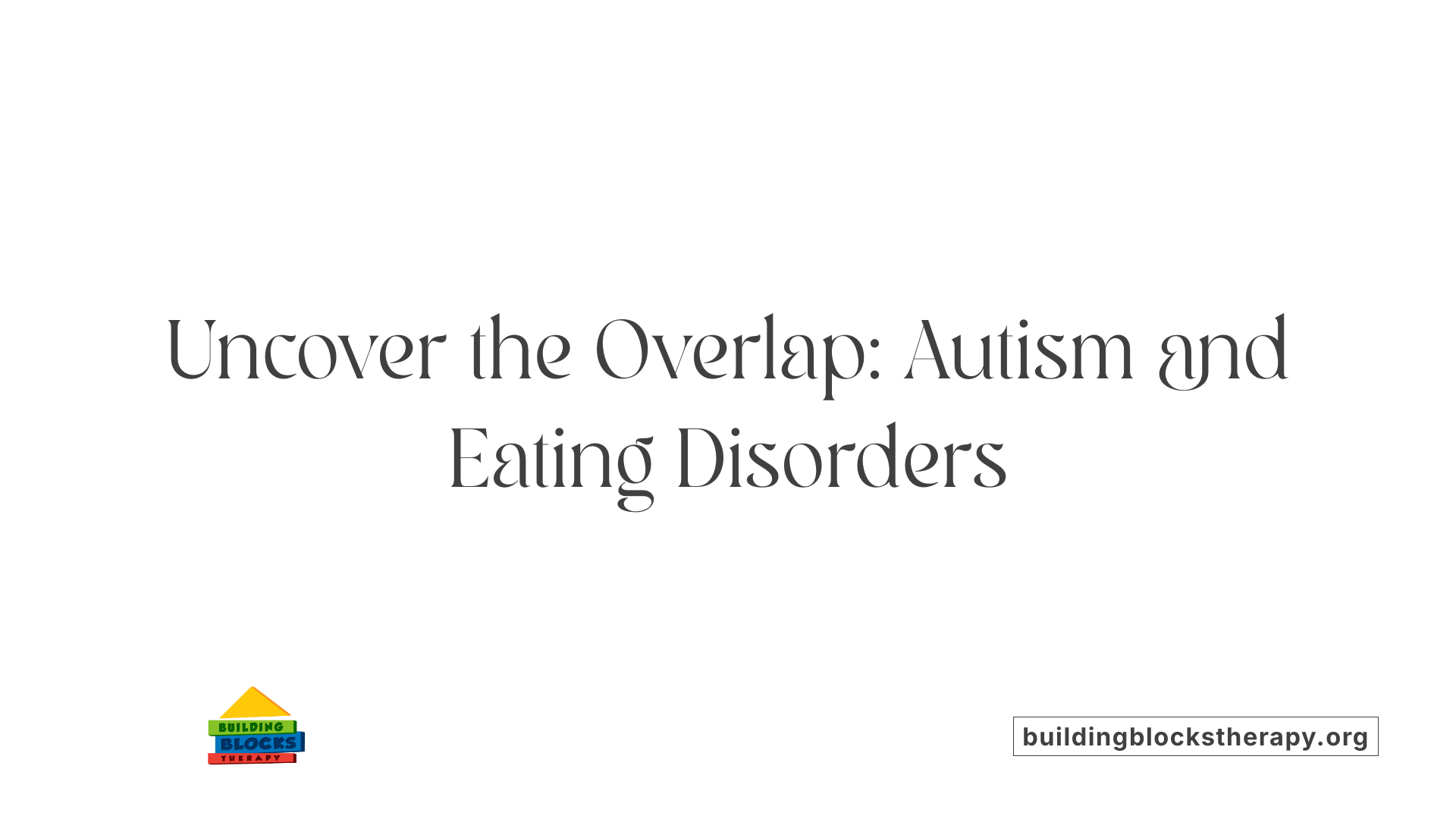
What is known about the prevalence of autism among individuals with eating disorders?
Research has shown that up to 20-35% of people with eating disorders, particularly anorexia nervosa, also meet criteria for autism spectrum disorder or exhibit high autistic traits. This significant overlap highlights how common co-occurrence is, especially among women.
Autistic individuals often develop eating issues due to sensory sensitivities to food textures, smells, or sights, as well as difficulties in emotional regulation and a preference for routines and control. These factors can lead to restrictive eating behaviors that mimic or evolve into diagnosable eating disorders.
Among different types of eating disorders, anorexia nervosa appears to be the most prevalent in autistic populations. Reports suggest that as many as 20-35% of women with anorexia might also be autistic. Autism and eating disorders often influence each other, often making treatment more challenging, as traditional approaches might not fully address the sensory and emotional needs of autistic individuals.
Significance of recognizing this overlap
Understanding the connection between autism and eating disorders is essential for effective treatment. Tailoring interventions to accommodate sensory sensitivities, routines, and emotional regulation strategies improves recovery outcomes.
Early identification of autism traits in those with eating disorders can lead to more personalized care plans, reducing treatment resistance and enhancing well-being.
Recognizing this overlap not only supports better clinical decisions but also promotes greater awareness of the neurodiversity involved in disordered eating, fostering compassionate and informed support approaches.
Impact of Autism on Eating Behaviors
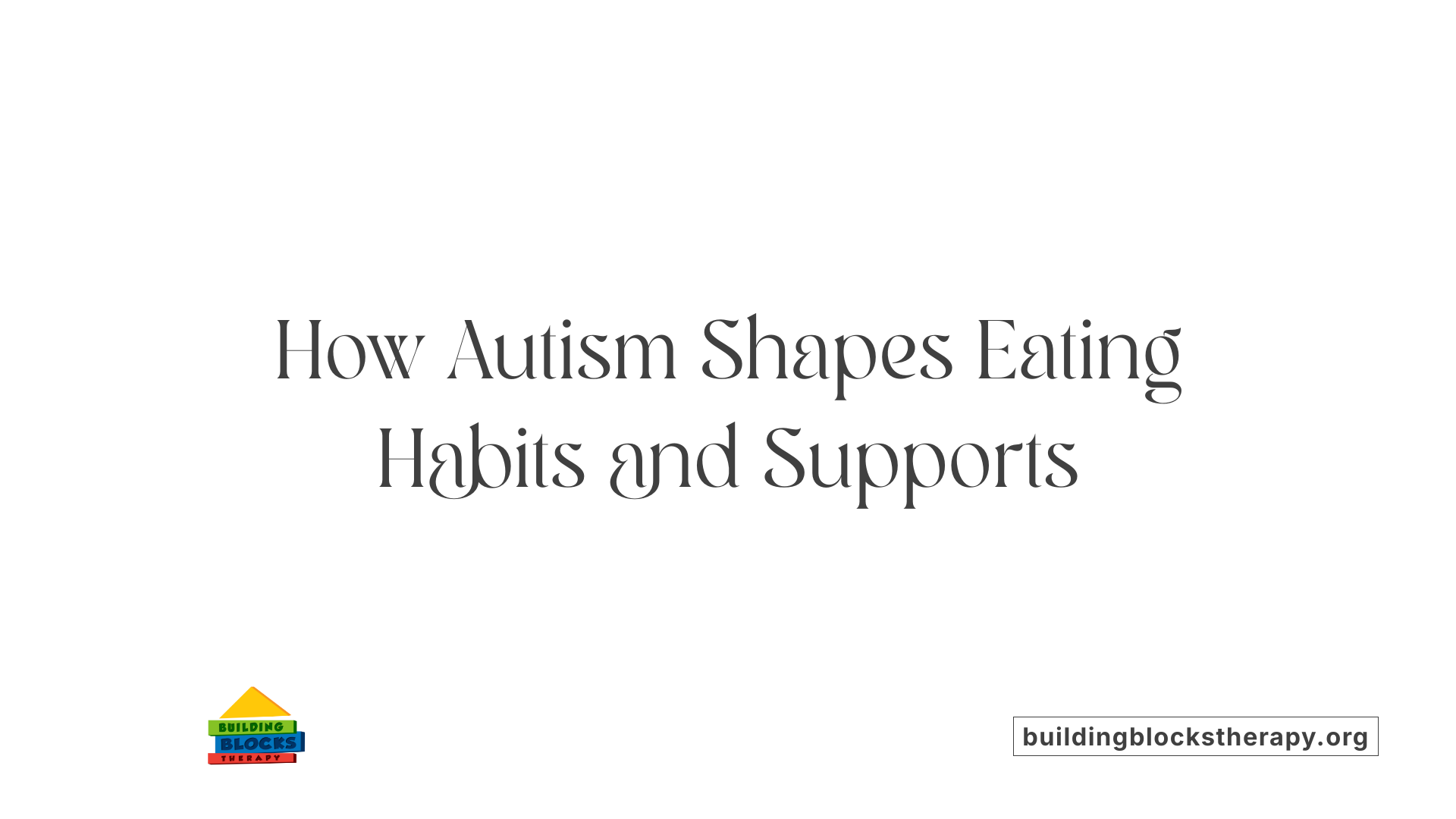
How does autism affect eating behaviors and strategies to support autistic individuals?
Autistic individuals often experience unique challenges related to their sensory processing, which have a significant impact on their eating habits. Many are highly sensitive to tastes, textures, smells, or sight of foods. For example, they may reject foods with certain textures or strong smells, or become overwhelmed by loud noises or busy environments during meals.
These sensory sensitivities can lead to food selectivity, where they might only eat a limited range of foods, often focusing on specific textures or flavors. Such restricted diets may cause nutritional gaps or gastrointestinal issues like constipation, reflux, or irritable bowel syndrome (IBS). Disruptions in interoception—the ability to recognize internal cues such as hunger or fullness—further complicate eating routines, making mealtimes stressful or unpredictable.
Supporting autistic individuals requires a thoughtful approach that prioritizes sensory-friendly accommodations. Creating predictable routines around meals, offering foods with preferred textures, and gradually introducing new tastes can help reduce food-related anxiety. Visual supports, social stories, and structured mealtime options also foster comfort and familiarity.
Moreover, some autistic people develop conditions such as Avoidant Restrictive Food Intake Disorder (ARFID) or Pica, which involve severe food avoidance or ingestion of non-food items respectively. These conditions often need specialized evaluation and intervention that respects their sensory needs.
In sum, understanding an autistic person’s sensory sensitivities, routines, and emotional responses to food is essential. Professional support from dietitians, psychologists, or occupational therapists experienced in neurodiverse care can significantly improve their mealtime experiences and nutritional health.
Diagnostic Challenges in Co-occurring Autism and Eating Disorders
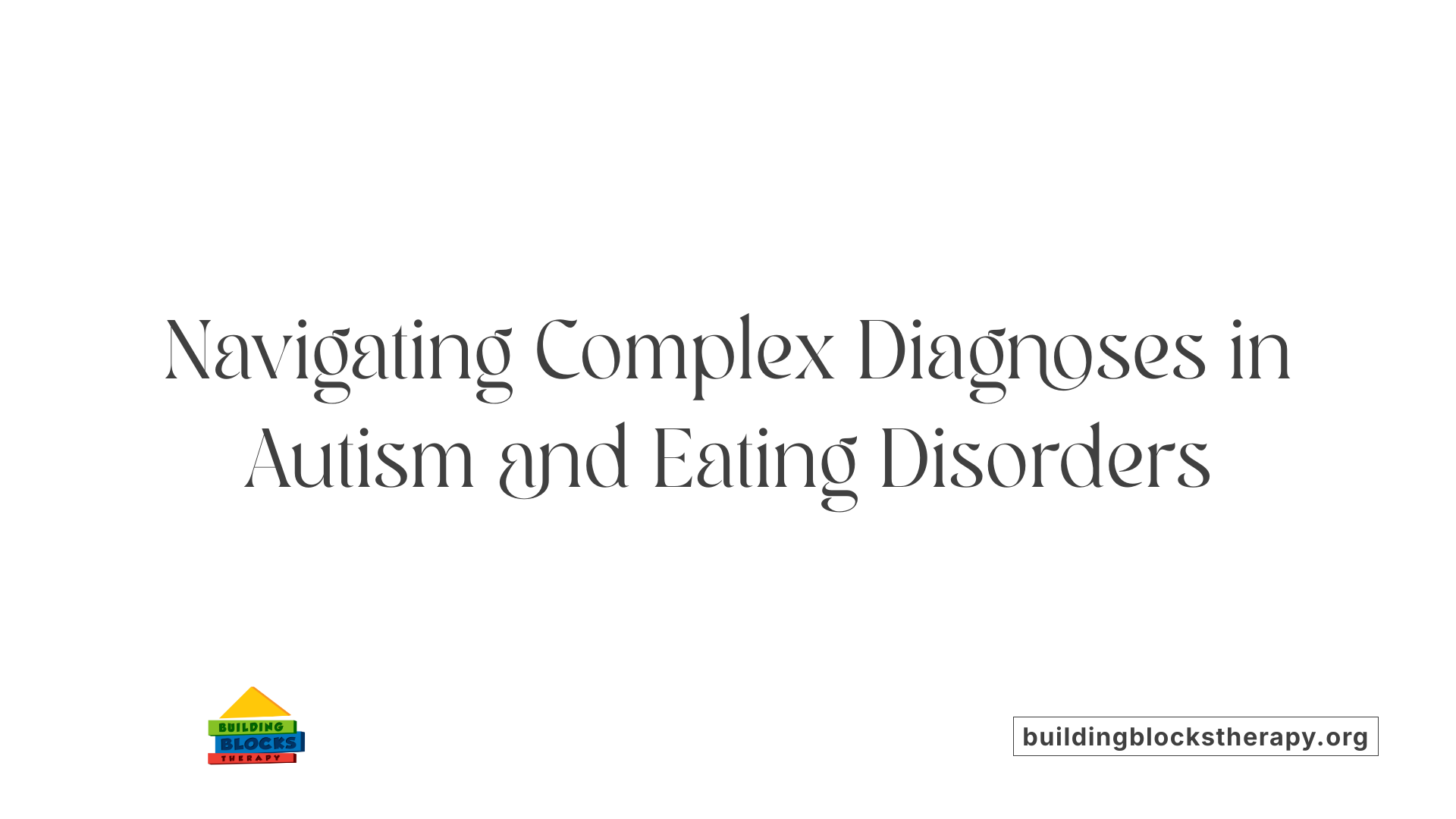
What are the diagnostic challenges when assessing co-occurring autism and eating disorders?
Diagnosing both autism spectrum disorder (ASD) and eating disorders at the same time can be quite complex for clinicians. One reason is that many symptoms overlap, such as sensory sensitivities—like hypersensitivity to textures or smells—and behavioral rigidity, including strict routines around eating. These shared traits can make it hard to determine whether behaviors are due to autism, the eating disorder, or both.
Adding to the difficulty, standard screening tools often do not have enough sensitivity or specificity to clearly distinguish between autism and eating disorders. For example, common questionnaires like the AQ-10 might miss cases or misclassify individuals due to their limited scope. Moreover, autism frequently goes undiagnosed, especially in females, because they often develop camouflaging behaviors that mask core symptoms. This delay in diagnosis can lead to worsening of symptoms and further muddle the clinical picture.
To improve accuracy, clinicians need to use more tailored assessment approaches. These should include detailed neurocognitive testing, sensory profiling, and careful observation of camouflaging behaviors. Awareness of the high rates of co-occurrence—research suggests that up to 20-35% of individuals with eating disorders also have autism—highlights the importance of comprehensive evaluation. Early and precise diagnosis is vital because it guides personalized treatment plans that address the unique needs of autistic individuals with disordered eating behaviors.
How Autism and Eating Disorders Interact at a Neurobiological Level
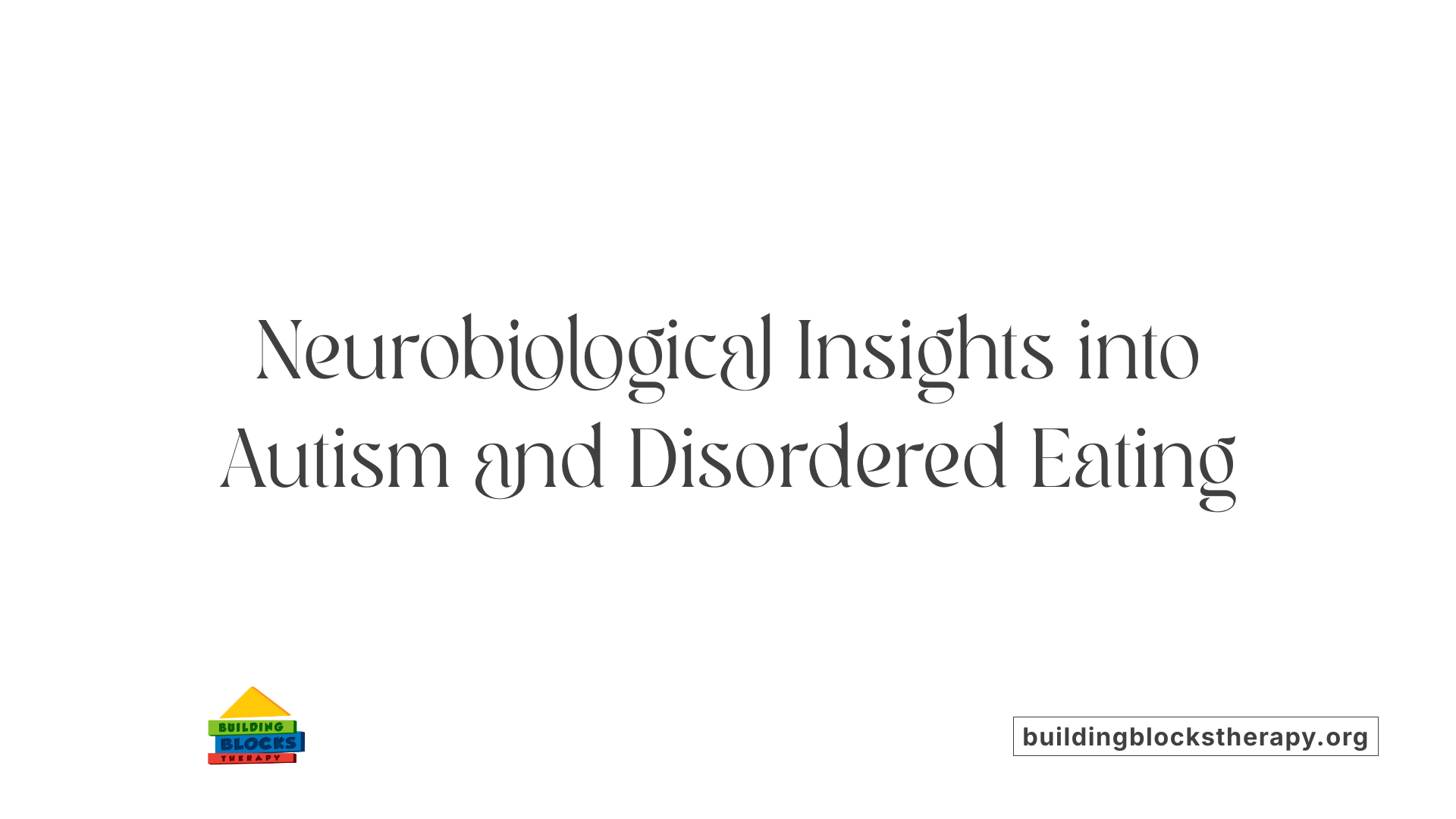
What is the relationship between autism and eating disorders?
Research shows a strong connection between autism and eating disorders, with estimates indicating that approximately 4% to 23% of individuals with eating disorders also meet criteria for autism. Autistic individuals often exhibit unusual eating behaviors, such as heightened sensitivities to textures, smells, and sights, as well as rigid routines and intense interests in food or calories. These behaviors are frequently driven by sensory processing differences and a need for predictability, rather than concerns about body image or weight.
Many autistic people restrict or avoid certain foods because of sensory aversions or routines, which can evolve into disordered eating patterns like ARFID (Avoidant/Restrictive Food Intake Disorder). Unlike typical eating disorders, these behaviors might not be motivated by a desire to control weight but instead serve to manage sensory overload, anxiety, or emotional regulation.
Statistics reveal that autistic women are particularly vulnerable; up to 35% of women with anorexia nervosa are also diagnosed with autism. Such overlaps highlight the importance of tailored treatment approaches that consider autism's neurobiological factors. Standard therapies often fall short, and effective management requires addressing sensory sensitivities, routine disruptions, and emotional challenges.
Shared genetic and neurobiological factors
Autism and eating disorders may share genetic and neurobiological underpinnings. Evidence suggests familial links and common neurobiological traits, such as differences in brain structure and function, which may predispose individuals to both conditions. For example, atypical neural pathways involved in sensory processing, emotional regulation, and behavior control can contribute to the development of restricted eating behaviors and social difficulties.
Neurocognitive features like mentalising and set-shifting impairments
Neurocognitive impairments are prominent in both autism and eating disorders. Many autistic individuals demonstrate difficulties with mentalising—the ability to understand others’ thoughts, feelings, and intentions—which can interfere with social interactions and emotional understanding. Similarly, set-shifting deficits, which involve challenges in switching between tasks or thoughts, are common in individuals with anorexia and other eating disorders.
Studies show that these impairments are linked to more persistent and severe eating disorder symptoms, especially in autistic individuals. Difficulty in mentalising may hinder emotional regulation, while set-shifting problems can reinforce rigid routines and obsessive behaviors related to food and body image.
Autism's influence on emotion regulation and control behaviors
Autism can impact emotional regulation, often leading to heightened anxiety and compulsive control behaviors around food. Many autistic individuals use restrictive eating or obsessive rituals to cope with overwhelming emotions, sensory overload, or a need for control in unpredictable environments.
This reliance on control behaviors may serve as a way to manage anxiety or distress but can also reinforce disordered eating patterns. Recognizing these neurobiological influences is crucial for developing effective, individualized treatments that address both emotional regulation and sensory sensitivities.
Differences in clinical presentations
Clinically, autism-related eating issues often differ from typical eating disorders. Autistic individuals may not prioritize weight loss or body image but instead fixate on routines, sensory comfort, and managing emotional states. They are more susceptible to behaviors like food selectivity, ritualistic eating, and Pica, which are directly linked to sensory sensitivities and neurodevelopmental traits.
This variance in presentation suggests the necessity for neurodiversity-affirming approaches that accommodate sensory needs, communication styles, and emotional regulation strategies.
| Aspect | Typical Eating Disorder | Autism-Related Eating Behaviors | Neurobiological Commonalities |
|---|---|---|---|
| Underlying motivation | Weight control, body image | Sensory sensitivities, routines | Atypical neural pathways in sensory and emotional processing |
| Behaviors | Bingeing, purging, fasting | Food selectivity, ritualistic eating | Shared neurocircuitry involved in compulsivity and sensory processing |
| Treatment response | Usually responsive to standard therapy | May need tailored, sensory-friendly approaches | Neurobiological overlap suggests potential for integrated interventions |
Understanding the neurobiological links between autism and eating disorders facilitates the development of more effective, personalized treatments, improving outcomes for those affected by both conditions.
Treatment Approaches for Autistic Individuals with Eating Disorders
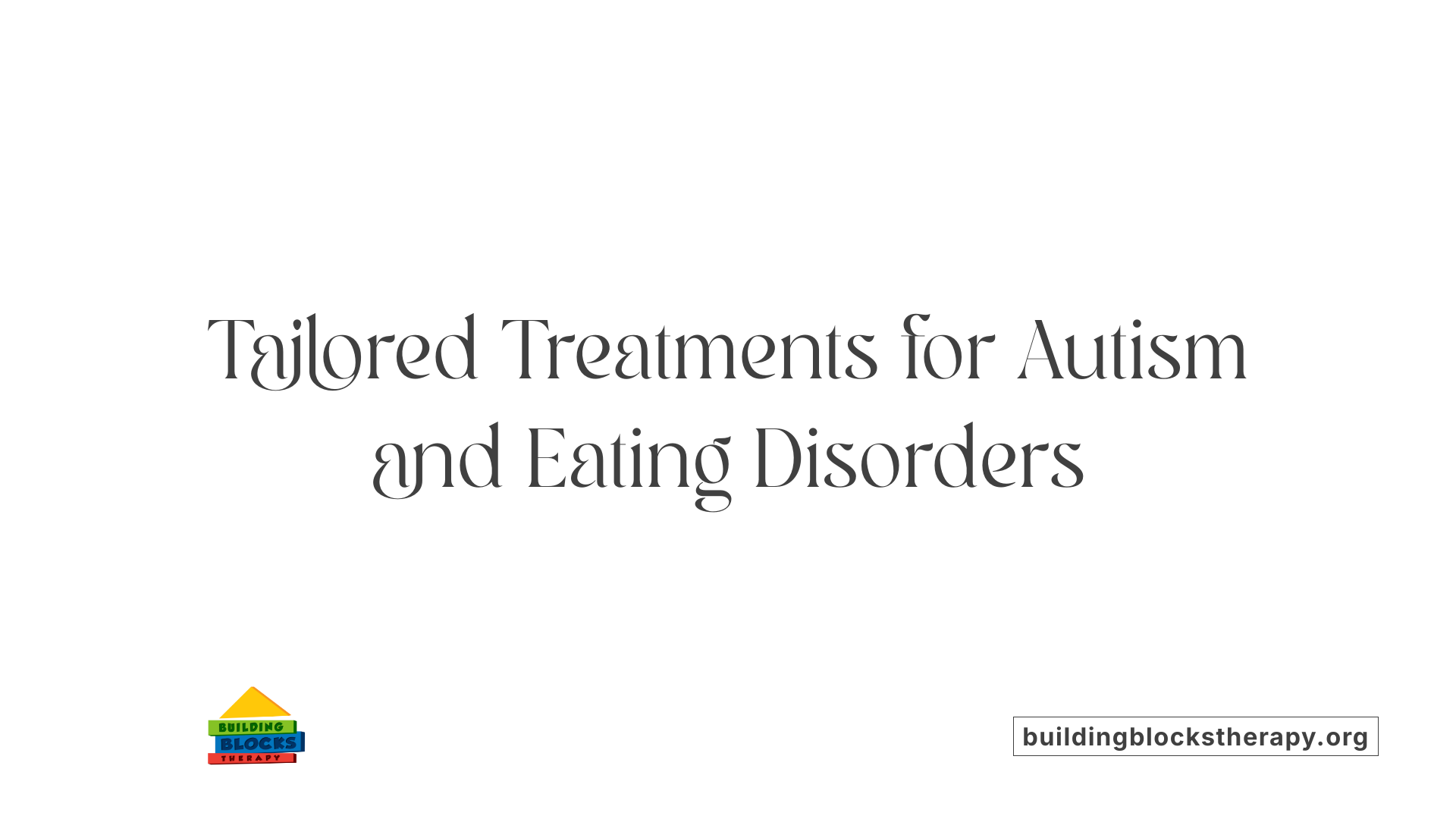
What treatment considerations should be taken into account for autistic individuals with eating disorders?
Treating autistic individuals with eating disorders requires a tailored, supportive approach that respects both the neurodiverse profile and the specific eating behavior issues. Clinicians should prioritize individualized strategies that are neurodiversity–affirming, meaning they recognize and respect autism’s unique traits and preferences.
Addressing sensory sensitivities is crucial, as many autistic people experience heightened reactions to textures, smells, and sights of food. Routines around eating are often deeply ingrained, so treatment should incorporate strategies that respect these routines while gradually encouraging adaptable behaviors.
Effective therapy plans often involve gradual exposure, structured support, and emotional regulation techniques aimed at reducing anxiety related to food and eating. Occupational therapy focusing on sensory integration can also be beneficial.
Working as part of a multidisciplinary team, including psychiatrists, psychologists, dietitians, and occupational therapists with experience in autism, improves the likelihood of successful outcomes.
Early screening for autism and ongoing collaboration with specialists can help tailor interventions that improve engagement and effectiveness.
Though autistic individuals may require more time and patience during recovery, their outcomes can approach those of neurotypical individuals when treatments are adapted accordingly.
Providing clear information, predictable routines, and a supportive environment is essential for encouraging progress. The goal is to create a safe space where individuals feel understood and are supported in their journey toward health.
The Role of Support Resources and Tailored Strategies
Support options for autistic individuals dealing with eating disorders are becoming more specialized and accessible. Programs like the PEACE Pathway are designed specifically to address the unique needs of autistic people, focusing on improving communication with healthcare providers and ensuring treatment is adapted to sensory sensitivities and routine preferences.
Various resources developed by clinicians and researchers help families and caregivers understand the complexities of autism-related eating behaviors. These include sensory-friendly eating strategies, structured routines, and tools to support emotional regulation. For example, sensory regulation techniques—such as the 3 E's (Emotions, Environment, Extras)—are used to manage eating disorder symptoms by creating a calm and predictable environment.
Communication aids are also vital in improving healthcare interactions. These aids help autistic patients express their needs effectively and enable healthcare providers to deliver more personalized care. Adjustments such as providing information in accessible formats, longer consultation sessions, or initial group observation help reduce anxiety and foster engagement.
Overall, tailored intervention approaches focus on building trust, acknowledging sensory differences, and supporting emotional and social needs. Combining these strategies enhances treatment effectiveness and promotes recovery for autistic individuals with eating disorders.
Worse Outcomes and Complication Risks in Co-morbid Conditions
Autistic individuals with eating disorders often experience more severe and prolonged illnesses. Their conditions tend to last longer, and they respond less effectively to standard therapies, which can lead to increased health risks.
Research indicates that when autism co-occurs with eating disorders like anorexia or ARFID, the likelihood of poor recovery and complications rises sharply.
One prominent concern is the heightened risk of nutritional deficiencies and physical health problems. Due to sensory sensitivities, many autistic people prefer limited food choices, frequently high in processed and carbohydrate-rich foods, while avoiding fruits, vegetables, and other nutrient-heavy options.
This selective eating behavior can result in deficiencies in vital nutrients like vitamins D and B12, calcium, zinc, and vitamin C, which are critical for overall health.
Complications such as gastrointestinal issues—constipation, diarrhea, and abdominal pain—are common and often worsen behavioral symptoms.
Early recognition of autism features in individuals with eating disorders is essential. Tailored interventions that address sensory, behavioral, and emotional challenges can improve outcomes.
Understanding these intertwined issues underlines the importance of comprehensive, early intervention strategies to minimize the risk of lasting health effects.
Toward Better Understanding and Care
Autism and eating disorders are intricately linked, presenting complex diagnostic and therapeutic challenges. Recognizing the prevalence of co-occurrence, understanding sensory and behavioral influences, and adopting tailored, neurodiversity-affirming interventions are vital. Enhanced awareness, specialized training for clinicians, and accessible resources can significantly improve outcomes for autistic individuals. Continued research and innovation in personalized care will pave the way for more effective support, ensuring that individuals with autism and eating disorders receive compassionate, effective treatment aligned with their unique needs.
References
- Eating Disorder Hotlines for 24/7 Crisis Help
- Eating Disorders and Autism
- Will eating disorder program help with autism-related food aversions?
- Eating disorders - National Autistic Society
- Potential mechanisms underlying the association between feeding ...
- Eating, eating disorders and autism | What is autism? - Autistica
- Eating disorders and autism - Beat






